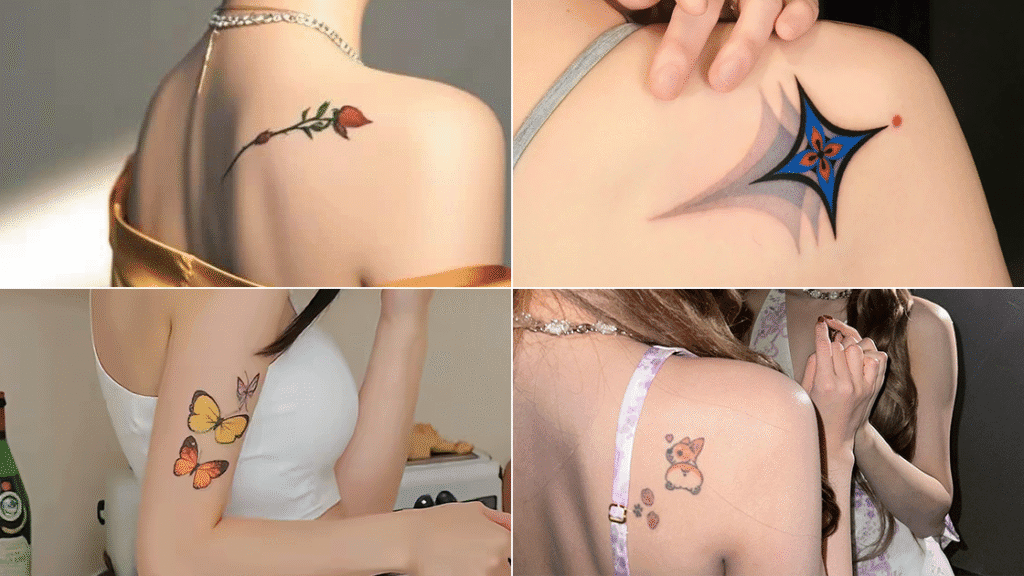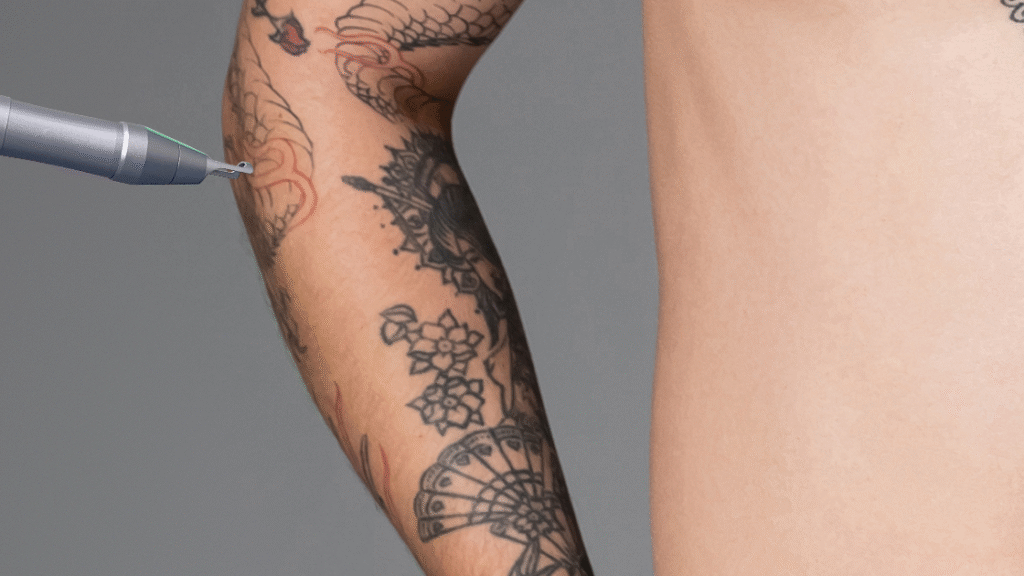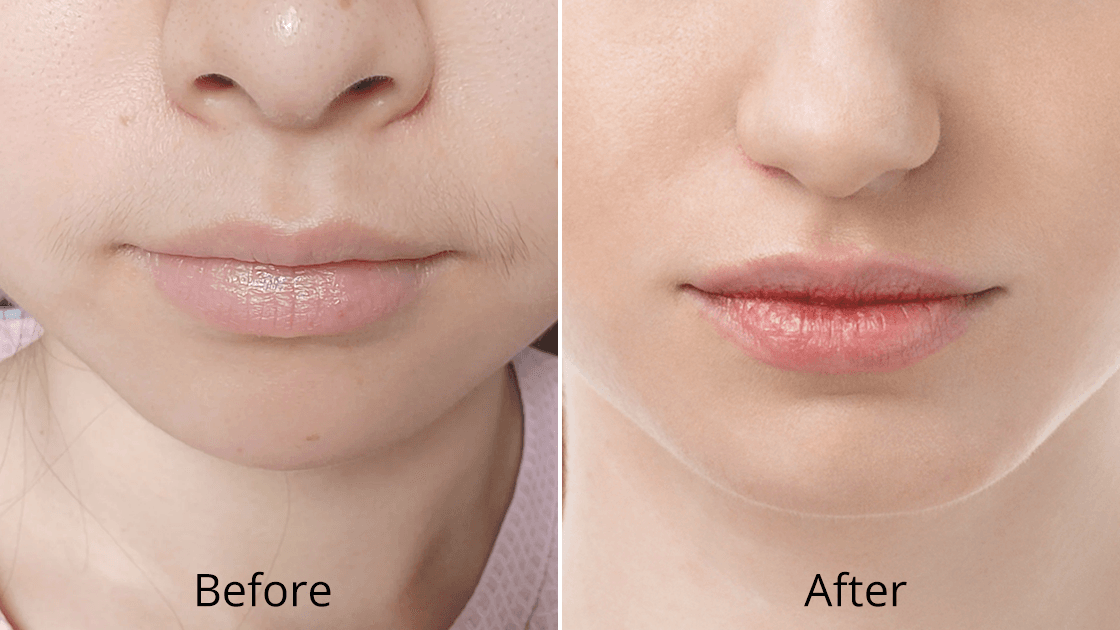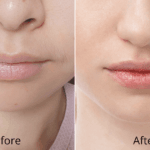1. Introduction
1.1 Overview of Pico Laser Technology
Picosecond laser technology represents a revolutionary advancement in aesthetic dermatology, delivering ultra-short pulses measured in picoseconds (trillionths of a second). This cutting-edge approach generates photoacoustic effects rather than photothermal damage, enabling more precise and effective treatment of tattoo pigments. The photomechanical action creates powerful pressure waves that shatter ink particles into smaller fragments, facilitating natural elimination through the lymphatic system while minimizing thermal damage to surrounding tissues.
1.2 Why Tattoo Removal Is in High Demand
The demand for tattoo removal services has increased dramatically, with an estimated 25% of tattooed individuals seeking removal procedures. Career changes, lifestyle modifications, relationship transitions, and evolving personal preferences drive this growing market. Additionally, advancements in laser technology have made removal procedures safer, more effective, and less painful than previous methods, encouraging more people to pursue treatment options they previously considered too risky or ineffective.
1.3 Purpose of the Article: Understanding Color Response in Pico Laser Tattoo Removal
Understanding how different tattoo colors respond to picosecond laser treatment is crucial for setting realistic expectations and developing effective treatment protocols. This comprehensive analysis examines the photophysical principles governing color-specific responses, wavelength optimization strategies, and clinical outcomes across various pigment types. By exploring these factors, patients and practitioners can make informed decisions about treatment approaches and anticipated results.
2. Understanding Pico Laser Technology in Tattoo Removal
2.1 What Is a Pico Laser?
A picosecond laser is an advanced medical device that emits laser energy in extremely short pulses, typically ranging from 300 to 750 picoseconds. These ultra-brief pulses create intense photoacoustic pressure waves that mechanically disrupt tattoo ink particles without generating significant heat. The technology utilizes Q-switched neodymium-doped yttrium aluminum garnet (Nd:YAG) or alexandrite laser systems, operating at specific wavelengths optimized for different chromophores and tissue interactions.
2.2 How Pico Laser Works on Tattoo Ink Particles
The picosecond laser mechanism operates through photoacoustic disruption rather than thermal ablation. When the ultra-short pulse encounters tattoo ink particles, it generates rapid thermal expansion and contraction cycles that create acoustic shock waves. These mechanical forces fragment the ink particles into significantly smaller pieces, often reducing them to nanometer-sized fragments that can be more efficiently processed by macrophages and eliminated through lymphatic drainage, resulting in faster clearance rates.
2.3 Advantages of Pico Laser Compared to Traditional Laser Tattoo Removal
Picosecond lasers offer substantial advantages over nanosecond Q-switched lasers, including enhanced particle fragmentation efficiency, reduced treatment sessions, minimized thermal damage, and improved safety profiles. The photoacoustic mechanism reduces the risk of hyperpigmentation, hypopigmentation, and scarring while providing superior clearance of recalcitrant colors. Additionally, the technology demonstrates effectiveness across all Fitzpatrick skin types, making it suitable for diverse patient populations with varying melanin concentrations.
2.4 Safety and Effectiveness of Pico Laser Treatments
Clinical studies demonstrate that picosecond lasers achieve excellent safety profiles with minimal adverse effects when operated by qualified practitioners. The technology’s selective photothermolysis principle ensures targeted ink destruction while preserving surrounding dermal structures. Common side effects include temporary erythema, edema, and mild discomfort, typically resolving within 24-48 hours. Long-term complications such as permanent pigmentary changes or scarring occur in less than 1% of properly treated cases.
3. The Science Behind Tattoo Ink Colors and Laser Response
3.1 How Tattoo Ink Colors Affect Laser Absorption
Tattoo ink absorption characteristics depend on the chromophore’s optical properties, including absorption coefficients, scattering parameters, and molecular structure. Dark pigments like carbon black exhibit broad absorption spectra, making them responsive to multiple wavelengths, while colored inks demonstrate selective absorption peaks. The optical density, particle size distribution, and chemical composition of different ink formulations significantly influence the photoacoustic response and subsequent fragmentation efficiency during picosecond laser treatment.
3.2 Role of Wavelength in Targeting Specific Colors
Wavelength selection is critical for optimizing color-specific removal, as different chromophores exhibit varying absorption characteristics across the electromagnetic spectrum. The 1064nm wavelength penetrates deeply and effectively targets dark pigments, while 755nm shows superior absorption in blue and green inks. The 532nm wavelength demonstrates optimal absorption in red, orange, and yellow pigments. Multi-wavelength systems provide comprehensive coverage across the visible spectrum, enabling practitioners to customize treatment protocols for specific color combinations.
3.3 Why Some Colors Are More Challenging to Remove
Certain tattoo colors present greater removal challenges due to their molecular structure, optical properties, and tissue interactions. Yellow and orange pigments often contain organic compounds with lower absorption coefficients, requiring higher fluences and more treatment sessions. White and flesh-toned inks may contain titanium dioxide, which can undergo photochemical reactions leading to darkening rather than fragmentation. Additionally, some modern synthetic inks demonstrate increased resistance to laser treatment compared to traditional carbon-based pigments.

4. Best Responding Tattoo Colors to Pico Laser
The effectiveness of picosecond laser treatment varies significantly across different tattoo colors, with some pigments showing excellent response while others require specialized approaches and extended treatment protocols.
4.1 Black Ink
4.1.1 Why Black Ink Is the Easiest to Remove
Black tattoo ink, primarily composed of carbon particles, demonstrates the highest absorption across multiple wavelengths, making it the most responsive color to picosecond laser treatment. Picosecond Nd-YAG laser was an effective and safe technique in the treatment of professional black tattoos; with only 2 sessions most patients reached excellent to moderate response with minimal side effects. The broad absorption spectrum of carbon allows for effective treatment with various wavelengths, while the high optical density ensures efficient energy absorption and subsequent fragmentation.
4.1.2 Common Wavelengths Used for Black Ink Removal
The 1064nm wavelength represents the gold standard for black ink removal, providing deep tissue penetration and excellent absorption characteristics. This near-infrared wavelength minimizes melanin absorption, reducing the risk of epidermal damage in darker skin types. The 755nm alexandrite wavelength also demonstrates effectiveness for black pigments, particularly in lighter skin types where melanin competition is less significant. Treatment protocols typically utilize fluences ranging from 3-8 J/cm² with appropriate spot sizes and repetition rates.
4.2 Blue and Dark Green Ink
4.2.1 Effectiveness of Pico Laser on Blue and Green Shades
Blue and dark green tattoo inks respond favorably to picosecond laser treatment, particularly with 755nm alexandrite wavelengths that demonstrate optimal absorption characteristics for these chromophores. The PicoWay™ is also especially effective at treating tattoos with black, red, or certain shades of green ink, and can also remove these colors in far fewer treatment sessions than other lasers on the market. The alexandrite laser’s absorption peak aligns well with the optical properties of copper phthalocyanine and other blue-green pigments commonly used in tattoo inks.
4.2.2 Recommended Treatment Protocols
Treatment protocols for blue and green inks typically employ 755nm wavelengths with fluences ranging from 4-10 J/cm², depending on the tattoo’s age, depth, and pigment density. Session intervals of 6-8 weeks allow adequate healing and immune system processing of fragmented particles. Most professional blue and green tattoos achieve significant clearance within 4-8 treatment sessions, though amateur tattoos may require fewer sessions due to lower pigment density and shallower depth placement.
4.3 Red Ink
4.3.1 Pico Laser Success with Red Pigments
Red tattoo pigments demonstrate excellent response to 532nm wavelength picosecond lasers, which provide optimal absorption characteristics for these chromophores. Red, yellow and orange pigments seemed to respond best to the 532 nm picosecond laser, with 75% to 100% clearance after an average of two treatments in most cases. The 532nm wavelength’s absorption peak aligns with the optical properties of cinnabar, cadmium selenide, and organic red dyes commonly used in tattoo formulations.
4.3.2 Factors Influencing Removal Rate
Several factors influence red ink removal rates, including the specific pigment composition, tattoo age, and skin type. Organic red dyes typically respond more favorably than inorganic compounds, while newer tattoos may require more sessions due to higher pigment density and deeper dermal placement. Fitzpatrick skin types I-III generally show better response rates, as melanin competition is minimal with 532nm wavelengths. Treatment intervals of 6-10 weeks optimize results while allowing complete healing between sessions.
4.4 Yellow, Orange, and Light Green Ink
4.4.1 Challenges in Removing Lighter Colors
Yellow, orange, and light green inks present unique challenges in laser tattoo removal due to their lower absorption coefficients and specialized chemical compositions. These pigments often contain organic compounds with narrow absorption bands, requiring precise wavelength matching for optimal results. Additionally, some yellow inks contain cadmium compounds that may produce unexpected color changes during treatment, necessitating careful monitoring and adjusted protocols to achieve desired outcomes.
4.4.2 How Pico Laser Addresses These Colors Differently
Picosecond lasers address challenging colors through optimized wavelength selection and modified treatment parameters. The 532nm wavelength shows the best response for yellow and orange pigments, though higher fluences and increased session numbers may be necessary. Some practitioners employ sequential wavelength treatments, beginning with longer wavelengths to avoid color changes and progressing to shorter wavelengths as the tattoo fades. This approach maximizes fragmentation efficiency while minimizing adverse photochemical reactions.
4.5 Response of Purple Ink to Pico Laser Treatments
Purple tattoo inks typically contain combinations of red and blue pigments, requiring dual-wavelength approaches for optimal removal. The 755nm wavelength effectively targets the blue components, while 532nm addresses the red elements. Treatment success varies depending on the specific pigment ratios and chemical compositions used in the original tattoo ink. Modern synthetic purple inks may demonstrate increased resistance compared to traditional formulations, requiring extended treatment protocols and careful monitoring of progress.
5. Factors Affecting Tattoo Removal Success Beyond Color
While color represents a primary determinant of treatment success, numerous additional factors significantly influence picosecond laser tattoo removal outcomes and must be considered when developing comprehensive treatment protocols.
5.1 Tattoo Age and Ink Quality
Tattoo age significantly impacts removal success, with older tattoos often responding more favorably due to natural fading processes and immune system degradation of ink particles over time. Professional tattoos typically contain higher quality, denser pigments that may require more treatment sessions, while amateur tattoos with lower pigment concentrations often clear more rapidly. Additionally, modern synthetic inks may demonstrate increased resistance to laser treatment compared to traditional carbon-based formulations used in older tattoos.
5.2 Skin Type and Color (Fitzpatrick Scale)
Patient skin type, classified according to the Fitzpatrick Scale, plays a crucial role in treatment planning and wavelength selection. Lighter skin types (I-III) generally respond better to shorter wavelengths like 532nm, while darker skin types (IV-VI) require longer wavelengths such as 1064nm to minimize melanin absorption and reduce pigmentary complications. Practitioners must carefully balance treatment efficacy with safety considerations, particularly in patients with higher melanin concentrations who face increased risks of post-inflammatory hyperpigmentation.
5.3 Tattoo Size and Location
Tattoo size and anatomical location significantly influence treatment outcomes and session requirements. Larger tattoos require more treatment sessions and longer overall treatment timelines, while location affects healing rates and immune system efficiency. Areas with better circulation, such as the trunk and proximal extremities, typically show faster clearance rates compared to distal locations like hands and feet. Additionally, areas subject to frequent movement or friction may experience delayed healing and require modified treatment protocols.
5.4 Number of Sessions and Treatment Intervals
Treatment success depends heavily on appropriate session spacing and total treatment numbers. Most professional tattoos require 6-12 sessions, while amateur tattoos may clear in 3-6 treatments. Optimal session intervals range from 6-12 weeks, allowing complete healing and immune system processing of fragmented particles. Rushing treatments with shorter intervals may compromise results and increase complication risks, while excessively long intervals may reduce treatment momentum and extend overall timelines.

6. What to Expect During and After Pico Laser Tattoo Removal
Understanding the treatment process and recovery expectations helps patients prepare for their picosecond laser tattoo removal journey and achieve optimal outcomes through proper compliance and care.
6.1 Typical Treatment Process
Picosecond laser tattoo removal begins with comprehensive consultation and assessment, including medical history review, skin type evaluation, and tattoo analysis. Treatment sessions typically last 10-30 minutes, depending on tattoo size and complexity. The procedure involves cleansing the treatment area, applying topical anesthesia if needed, delivering laser pulses with appropriate parameters, and providing immediate post-treatment care. Patients experience minimal discomfort during treatment, often described as rubber band snapping sensations.
6.2 Pain Management and Comfort
Most patients tolerate picosecond laser treatments well, with pain levels significantly lower than traditional tattoo application. Topical anesthetic creams applied 30-60 minutes before treatment provide adequate comfort for most patients, while cooling devices integrated into modern laser systems further reduce discomfort. Some practitioners offer nerve blocks or oral analgesics for patients with lower pain tolerance or extensive tattoos. Post-treatment discomfort typically resolves within 24-48 hours and responds well to over-the-counter pain medications.
6.3 Possible Side Effects by Color and Skin Type
Side effects vary based on treated colors and patient skin types, with most being temporary and self-limiting. Common immediate effects include erythema, edema, and mild crusting, typically resolving within 1-2 weeks. Hyperpigmentation risks are higher in darker skin types and with shorter wavelengths, while hypopigmentation may occur with aggressive treatment parameters. Color-specific reactions include darkening of white or flesh-toned inks and potential color shifts in complex polychromatic tattoos requiring careful monitoring and adjusted protocols.
6.4 Post-Treatment Care and Recovery Tips
Proper post-treatment care significantly influences healing outcomes and complication prevention. The treated area should be cared for delicately until healing is completed and care should be taken to avoid trauma to the area for the first 7 days after treatment. Essential care instructions include keeping the area clean and dry, applying prescribed topical antibiotics, avoiding sun exposure, and refraining from picking at scabs or crusts. Patients should avoid swimming, saunas, and excessive sweating for 48-72 hours post-treatment to prevent infection and optimize healing.
| Ink Color | Recommended Wavelength | Average Clearance Rate | Clinical Notes |
| Black | 1064 nm | 90%–95% | Easiest to remove; deep ink absorbs 1064 nm effectively |
| Red | 532 nm | 75%–90% | Good response; may cause transient redness |
| Blue | 755 nm / 1064 nm | 70%–85% | Varies by shade; darker blues clear faster |
| Dark Green | 755 nm | 65%–80% | Better with picosecond Alexandrite laser (755 nm) |
| Orange | 532 nm | 60%–75% | Lighter pigment; better response than yellow |
| Purple | 532 / 755 nm | 50%–70% | May require more sessions; response varies |
| Yellow | 532 nm | 40%–60% | One of the most difficult to remove due to low absorption |
| Light Green | 532 / 755 nm | 35%–55% | Very resistant; needs multiple sessions and high precision |
7. Final Thoughts: Which Colors Respond Best and What It Means for You
Black ink responds best to picosecond laser treatment, with excellent clearance rates using a 1064 nm wavelength. Blue, dark green, and red pigments also show strong results. Red, yellow, and orange inks respond well to 532 nm picosecond lasers, achieving 75%–100% clearance after just two sessions in many cases. However, colors like yellow, orange, and light green may require more sessions and specialized approaches. Success depends on more than color—it also involves skin type, tattoo age, ink depth, and proper aftercare. Modern pico laser technology offers effective solutions for nearly all tattoo colors when applied by trained professionals. Choosing an experienced practitioner with access to multiple wavelengths and knowledge of color-specific protocols is key. Tattoo removal is a gradual process requiring patience and realistic expectations, but with proper planning, excellent results are achievable across the full color spectrum.
8. FAQs About Pico Laser Tattoo Removal and Colors
A: Session requirements vary significantly based on colors present, tattoo size, and individual factors. Black ink typically requires 4-8 sessions, while challenging colors may need 8-15 treatments. Your practitioner will provide personalized estimates during consultation.
A: While modern picosecond technology can treat all colors, complete removal isn’t guaranteed for every tattoo. Most achieve 80-95% clearance, with some residual shadowing possible, particularly with challenging colors or densely applied professional tattoos.
A: Color removal difficulty relates to the ink’s optical properties and absorption characteristics. Dark colors absorb laser energy efficiently, while lighter colors have lower absorption coefficients, requiring more treatments and higher energy levels.
A: Yes, multi-wavelength systems can safely treat multiple colors simultaneously. However, some practitioners prefer sequential treatments to monitor individual color responses and adjust parameters accordingly.
A: Color changes can occur, particularly with white, flesh-toned, or certain red inks. Most changes are temporary, but some may require additional treatments with different wavelengths to achieve complete clearance.
A: Professional assessment determines optimal wavelength selection based on your specific colors, skin type, and tattoo characteristics. Multi-wavelength systems provide the most comprehensive treatment options.








